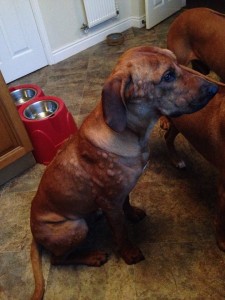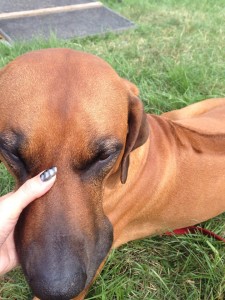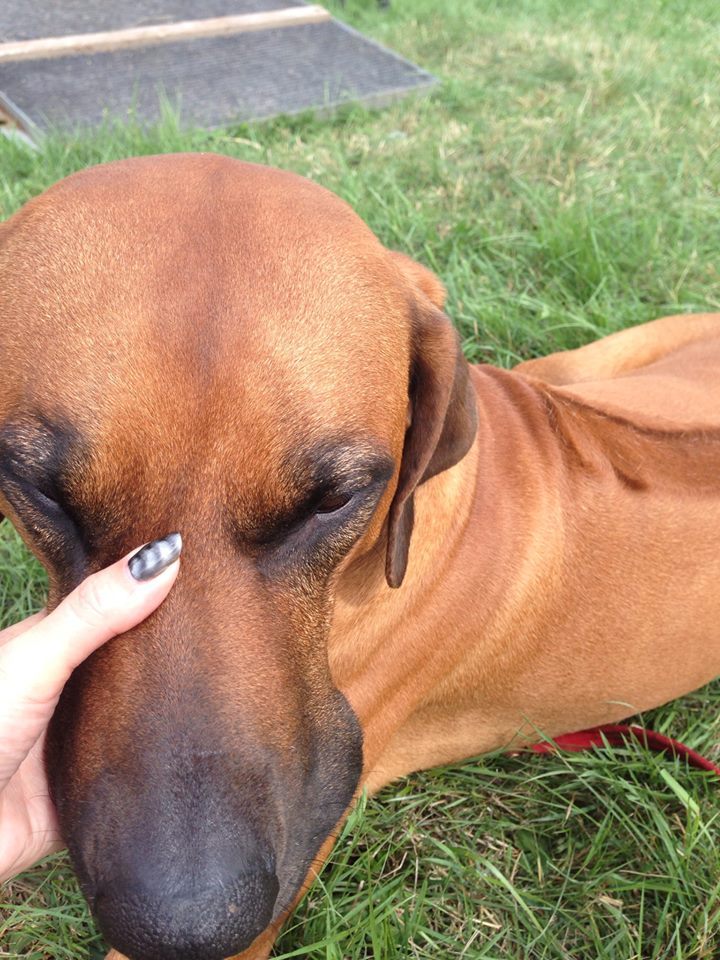Bee & Wasp Stings – In the summer and early autumn, stings from bees and wasps are an occupational hazard for a dog. Because they like to roam about investigating the undergrowth and hedgerows whenever they can, I suppose it’s inevitable that they’ll come across the odd sting or two.

Maybe you might notice the actual moment when they are stung, or perhaps you might just see the reaction they have to it. Sometimes there might be a soft swelling on the face, paws or muzzle after rooting about, and if your dog has a short coat, then he might even get some raised blotches on his body too.
Often the bee or wasp may actually be on the ground when your dog passes by resulting in him or her getting stung on the paw or pad if he steps on it. If this happens, you may not be able to see the stinger or any “injection site”, but you will see how the dog is acting. Typically, you may hear a help (if they’re as much of a big girl’s blouse as my lot) or perhaps they may be limping. Often when a dog limps we think they have damaged their joints or bones or may be even their nails but sometimes it can be a bite or a sting causing the problem. You may see them nibbling at their foot as if it is itchy, rather than actually painful. This uncomfortable itchy feeling could make them try to scuff or scratch their pad along the surface of the floor to try to scratch the itch, a little like the action of wiping their feet.

Whether its wasps or bees, it’s not really a very serious problem for most dogs and is certainly not life threatening unless they either have a severe allergic reaction or are stung on the mouth/throat area. Either of these situations may cause the windpipe to swell up and make it really difficult to breathe and if the airway swells up too much, it might even cut off the breathing altogether and suffocate the animal, so remember to treat a sting to the mouth or throat as an emergency.
Otherwise, treating stings is really quite straight-forward. If the dog has been stung by a wasp, there will be no stinger left behind. In the case of a bee, it likely that you will actually be able to see the entire stinger still stuck in the dog and possibly even still pulsing. Our goal is to remove the sting from the dog and then neutralise the protein string that makes up the stinging sensation.
Never squeeze the stinger as you remove it. This may inject further painful venom into the dog. Instead, use a sharp edged piece of plastic such as a credit card and scrape the sting off on a diagonal in one swift movement.
If you are unsure as to whether it was a bee or wasp that did the stinging, its important that you do not try to neutralise the venom as if you pick the wrong antidote, you will in fact make the sting even more painful. In this case, you can bathe the affected areas in cold water or use ice packs for around 15 minutes to reduce the swelling and irritation.
If you DO know which type of sting you are dealing with, then so far as neutralising the sting goes, the best way to help you remember which sting needs which treatment is to pair up the initials as follow:-
Bee Sting = Bicarbonate of soda.
A bee sting is acidic, so you need to use something alkaline to neutralise it’s action and the best thing for the job is Bicarbonate of Soda.
Wasp Sting = Vinegar (well, I reckon 2 V’s look like a W)
A wasp sting is alkaline and so we need to bathe it in a dilute acid solution to neutralise the effect. A good source of dilute acid is vinegar, or you could use lemon juice too. It wouldn’t be the first time I’ve resorted to squirting Axl outside a Fish and Chip shop with a bottle of Sarson’s vinegar when he’s been stung!
A cold compress or ice pack will help ease the irritation and, if the dog has been prescribed an antihistamine such as Piriton before, you may use this to help with any discomfort. Piriton can be re-administered 8 hours later if necessary. Please DO NOT administer Piriton if it has not been prescribed for your animal previously by a vet. For some dogs, the active ingredient in the medication can actually be more dangerous than the reaction you are treating and in some cases may prove fatal so please do check with your vet BEFORE you need it, and keep it in your doggy first aid kit if he is happy for you to use it with your dog.


